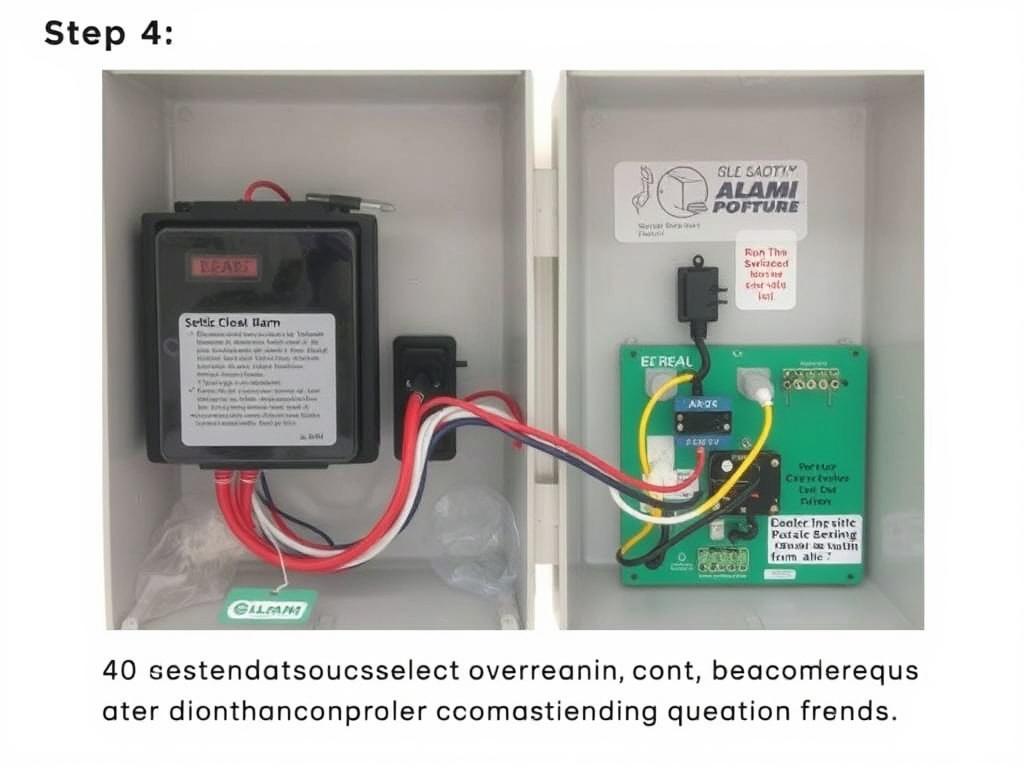When it comes to maintaining a septic system, one of the best ways to prevent costly repairs and avoid unpleasant surprises is by installing a septic tank alarm. This simple but effective device alerts you when the sewage levels in your tank are too high, giving you time to take action before any backups or overflows occur. Whether you are a homeowner with a septic system or a professional installer, knowing how to install a septic tank alarm can save you hours of frustration and thousands of dollars in damage control. In this article, we’ll walk you through the entire process, from understanding the components involved to ensuring your alarm is working perfectly.
- Understanding Septic Tank Alarms and Why You Need One
- Components of a Septic Tank Alarm System
- Step 1: Gather Your Materials and Tools
- Step 2: Locate Your Septic Tank and Pump Chamber
- Step 3: Install the Float Switch Inside the Tank or Pump Chamber
- Step 4: Run Wiring from the Float Switch to the Control Panel
- Step 5: Mount the Control Panel and Attach the Alarm Sounder
- Step 6: Test the Septic Tank Alarm
- Additional Tips and Maintenance for Septic Tank Alarms
- Common Problems When Installing a Septic Tank Alarm and How to Avoid Them
- Environmental and Safety Considerations
- Comparing Popular Septic Tank Alarm Brands
- When to Call a Professional Installer
- Cost Breakdown: What to Expect When Installing a Septic Tank Alarm
- How to Choose the Best Spot for Your Alarm Control Panel
- Final Words: Keeping Your Septic System Safe with an Alarm
- Conclusion
Understanding Septic Tank Alarms and Why You Need One
Before diving into the installation itself, let’s take a moment to understand what a septic tank alarm is and why it’s so essential. Simply put, a septic tank alarm is a monitoring device designed to detect the level of wastewater in your septic tank or pump chamber. When the wastewater reaches a critical level—due to a clog, pump failure, or heavy usage—the alarm activates, warning you with a loud sound and sometimes a flashing light. This early warning system gives you valuable time to call a professional, schedule a pump-out, or fix an issue before it escalates.
Many septic systems do not come with alarms pre-installed, and this can result in unnoticed failures leading to backups inside your home or costly damage to your drain field. If you have a septic system for your home or business, installing a septic tank alarm is a smart investment that pays off by protecting your system’s longevity and saving you money and stress.
Components of a Septic Tank Alarm System
Before we get into the installation steps, it’s important to know the key parts of a septic tank alarm system. Here’s a simple breakdown in a table:
| Component | Description | Function |
|---|---|---|
| Float Switch | A float attached to a wire or rod | Detects liquid levels inside the septic tank or pump chamber |
| Control Panel | Wiring connections and casing outside the tank | Receives signal from float switch and triggers alarm |
| Alarm Sounder | Buzzer, siren, or horn unit | Emits noise when triggered to alert homeowners |
| Indicator Light | LED or flashing light on the control panel | Visual cue accompanying the sound alarm |
| Power Source | Battery or electrical connection | Powers the alarm system |
By familiarizing yourself with these components, you’ll better understand where each part fits and how to connect them during installation.
Step 1: Gather Your Materials and Tools
Now that you know what the system consists of, the next step is preparation. Having all the right tools and materials handy before you start will make the process smoother and safer. Here’s a helpful checklist:
- Septic tank alarm kit (including float switch, control panel, alarm sounder, and necessary wiring)
- Wire strippers and cutters
- Screwdrivers (flathead and Phillips)
- Drill with appropriate bits (if mounting outside the tank)
- Electrical tape and waterproof connectors
- Safety gloves and eye protection
- Multimeter (to check electrical continuity and voltage)
- Ladder or stool (if your tank access is elevated)
Make sure your septic tank alarm system is compatible with your existing septic setup. Some alarms work specifically with certain types of tanks or pumps, so always check the manufacturer’s specifications before purchasing.
Step 2: Locate Your Septic Tank and Pump Chamber
The alarm’s float switch needs to be placed inside the septic tank or pump chamber where it can effectively monitor liquid levels. This might sound straightforward, but every property is different. First, you need to locate the tank and, if applicable, the pump chamber cover.
Usually, your septic tank is buried underground, with an access lid or riser near the surface. If you don’t know where your system is located, you can refer to your property’s installation plans or use a metal detector to find the tank lid. Remember never to enter the tank itself, as hazardous gases and confined spaces make it extremely dangerous.
The pump chamber is a smaller area connected to the septic tank where a pump moves wastewater out to the drain field. If your system uses a pump, that’s where you’ll install the alarm. In gravity-fed systems without a pump, the float is sometimes installed in the tank itself to monitor liquid levels.
Step 3: Install the Float Switch Inside the Tank or Pump Chamber
With the tank or pump chamber located and access gained, it’s time to start the actual installation.
First, ensure the power source is turned off to avoid electric shocks. The float switch typically has a weighted float attached to a cable, designed to rise and fall with the wastewater level.
- Lower the float switch carefully into the tank or pump chamber, securing the cable somewhere on the access lid or riser to prevent it from moving around.
- Attach the float switch at the correct height based on your tank’s specifications so it trips the alarm at the right level (usually just before the tank overflows).
- Make sure the float switch can move freely and is not obstructed by float balls, tank walls, or other components.
In some models, you may need to secure the float cable to a mounting bracket fixed inside the chamber. Follow your manufacturer’s instructions carefully.
Step 4: Run Wiring from the Float Switch to the Control Panel

After placing the float switch, the next step is wiring it to the control panel, which is typically mounted outside the septic tank in a dry, accessible location.
Here are some tips for wiring:
- Choose a weatherproof control panel case rated for outdoor installation.
- Run the wires along the tank riser or access pipe, using clips or cable ties to secure them neatly.
- Where the cable passes from underground to above ground, use a conduit to protect it from damage and moisture.
- Connect the float switch wires to the control panel terminals, following the wiring diagram supplied with your alarm kit.
- Use waterproof connectors or electrical tape to seal all connections and prevent corrosion.
If you’re unsure about electrical wiring, this might be a good time to consult a licensed electrician for safety.
Step 5: Mount the Control Panel and Attach the Alarm Sounder
The control panel needs to be mounted on a wall or post near your tank for easy access and visibility. Use the supplied mounting hardware to fix the panel securely.
Next, attach the alarm sounder—a buzzer or siren—close to the control panel or in a place where you will hear it loud and clear inside your home or property. Some alarms also feature indicator lights that flash when triggered.
- Make sure the alarm is securely attached.
- Verify the power source: most septic alarms use a 110V household supply or batteries. Check your alarm requirements.
- Connect the alarm sounder and indicator lights to the control panel as per the instructions.
- Ensure all wiring is neat, labeled, and protected from weather or animals.
Step 6: Test the Septic Tank Alarm
Testing is a crucial step to make sure your septic tank alarm is functioning perfectly. Here’s how to do it:
| Test Step | What to Do | Expected Result |
|---|---|---|
| Power On | Turn on the power to the control panel and alarm | Alarm should have power, indicator lights steady (if applicable) |
| Simulate High Level | Manually lift the float switch to the alarm position | Alarm sounder activates, indicator light flashes |
| Reset Alarm | Lower the float switch to normal position | Alarm stops, indicator light goes off or resets |
| Check Battery Backup (if any) | Turn off main power and verify alarm runs on batteries | Alarm remains operational for specified backup time |
If the alarm does not activate during testing, re-check all wiring connections and float switch positioning. Use a multimeter for continuity testing if needed.
Additional Tips and Maintenance for Septic Tank Alarms
Installing a septic tank alarm is just the beginning. To ensure your system functions reliably for years, here are some housekeeping tips:
- Regularly inspect alarm components for damage, corrosion, or loose wires.
- Test your alarm monthly or at least quarterly to verify it is operational.
- Change batteries annually if your alarm uses a battery backup.
- Schedule routine septic tank pumping and inspections to keep the system running smoothly.
- Keep an emergency contact for septic pumping services readily available in case the alarm goes off.
With these essential maintenance steps, your septic tank alarm will provide peace of mind and help you avoid messy backups.
Common Problems When Installing a Septic Tank Alarm and How to Avoid Them
Even though installing a septic tank alarm might seem simple, some typical issues can crop up if you’re not careful. Below is a list of common problems and quick solutions:
- Incorrect float switch placement: The float may get stuck or fail to float freely. Solution: Ensure enough clearance and proper cable securing.
- Poor electrical connections: Leads to alarm failure or false warnings. Solution: Use waterproof connectors and test continuity.
- Not securing wires properly: Can cause wires to break or short out. Solution: Use cable ties and conduits where needed.
- Wrong alarm type for your system: Different septic systems may need different alarm types. Solution: Check manufacturer compatibility before purchase.
- Ignoring regular testing: Might mean your alarm won’t work when needed. Solution: Set a reminder to test monthly.
By keeping these considerations in mind during and after installation, you can ensure your septic tank alarm serves you well.
Environmental and Safety Considerations
Working with septic tanks requires extra caution because of the potential health hazards involved. Sewage gases inside tanks can be toxic or explosive, so always:
- Avoid entering the tank under any circumstances.
- Wear protective gloves and eyewear when working close to septic openings.
- Ensure all electrical components are installed following local electrical codes to prevent shocks or fire hazards.
- Dispose of any waste or old alarm parts properly.
By following safety guidelines and environmental best practices, your septic system will be not only effective but safe for you and your family.
Comparing Popular Septic Tank Alarm Brands
Choosing the right septic tank alarm can be tricky with so many options available. Here’s a concise comparison table of a few popular brands to help you decide:
| Brand | Power Source | Float Type | Features | Approximate Price |
|---|---|---|---|---|
| Zoeller | 110V with battery backup | Weighted float cable | Easy install, audible & visual alarms, reliable | $150 – $200 |
| Premier Alarm | 12V DC with solar options | Compact float switch | Wireless monitoring option, energy-efficient | $180 – $250 |
| Basement Watchdog | Battery operated | Submersible float sensor | Portable, great for retrofit applications | $90 – $130 |
| Little Giant | 110V with optional battery backup | Dual float sensors | Alarm plus pump control options | $200 – $280 |
While price is a factor, consider features that fit your system size and power availability to select the best alarm for your needs.
When to Call a Professional Installer

Although installing a septic tank alarm can be a manageable DIY project, some situations warrant professional help:
- If you are uncomfortable working with electrical wiring.
- If your septic tank is located in a hard-to-access or hazardous spot.
- If your septic system has unique configurations requiring customized solutions.
- If local building codes require certified installation or permits.
A professional installer can ensure the alarm system is up to code, safely installed, and properly integrated with your existing septic system.
Cost Breakdown: What to Expect When Installing a Septic Tank Alarm

If you’re curious about the overall investment when you install a septic tank alarm, understanding the cost components helps with budgeting:
| Item | Average Cost (USD) | Notes |
|---|---|---|
| Septic Tank Alarm Kit | 90 – 280 | Depends on brand and features |
| Electrical Wiring and Materials | 20 – 50 | Cables, connectors, conduit |
| Professional Installation (optional) | 150 – 300 | Costs vary by region and complexity |
| Routine Maintenance | 10 – 20 annually | Batteries, inspection, minor repairs |
DIY installation can significantly reduce costs, but professional help offers peace of mind and compliance with safety regulations.
How to Choose the Best Spot for Your Alarm Control Panel
Picking the right location for your alarm’s control panel is crucial for convenience and functionality. Here are some key factors to consider:
- Accessibility: Install in a location easy to reach for testing and maintenance, like a garage wall or near your main electrical panel.
- Weather protection: Choose a dry, sheltered area to protect from rain, snow, and direct sun.
- Visibility: The alarm sound and indicator lights should be noticeable from living areas to prevent missed warnings.
- Power source availability: Ensure the location has a proper power outlet or can accommodate batteries.
Balancing these considerations will ensure your septic tank alarm is both effective and user-friendly.
Final Words: Keeping Your Septic System Safe with an Alarm
Installing a septic tank alarm is one of the smartest ways to protect your septic system and your home from nasty backups and expensive repairs. By understanding the components, preparing properly, and following each installation step carefully, you can have a reliable early warning system in place. Remember to test regularly, maintain the alarm, and address any alerts promptly. Whether you choose a DIY installation or prefer a professional, this preventive measure will give you peace of mind knowing your septic system is being monitored around the clock.
Conclusion
Septic systems play a vital role in managing household waste safely, but they require vigilant care to avoid disasters. Installing a septic tank alarm is a practical, cost-effective way to ensure you’re alerted early if problems arise. From selecting the right alarm kit and positioning the float switch correctly to careful wiring, mounting, and testing, each step is important for a functioning system. Ultimately, understanding how to install a septic tank alarm and maintaining it regularly will save you from unexpected headaches and keep your septic system running smoothly for years to come. Don’t wait for a backup to remind you; take proactive action and secure your home’s sanitation with this simple, reliable technology.
Помогла вам статья?






